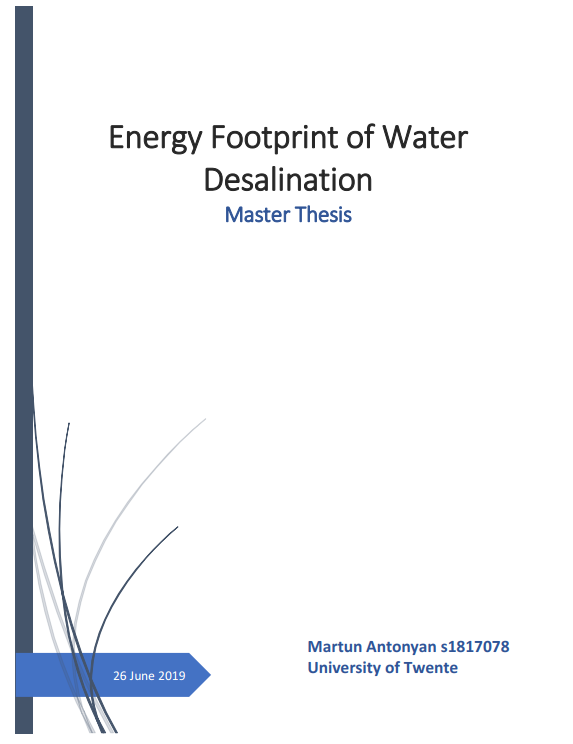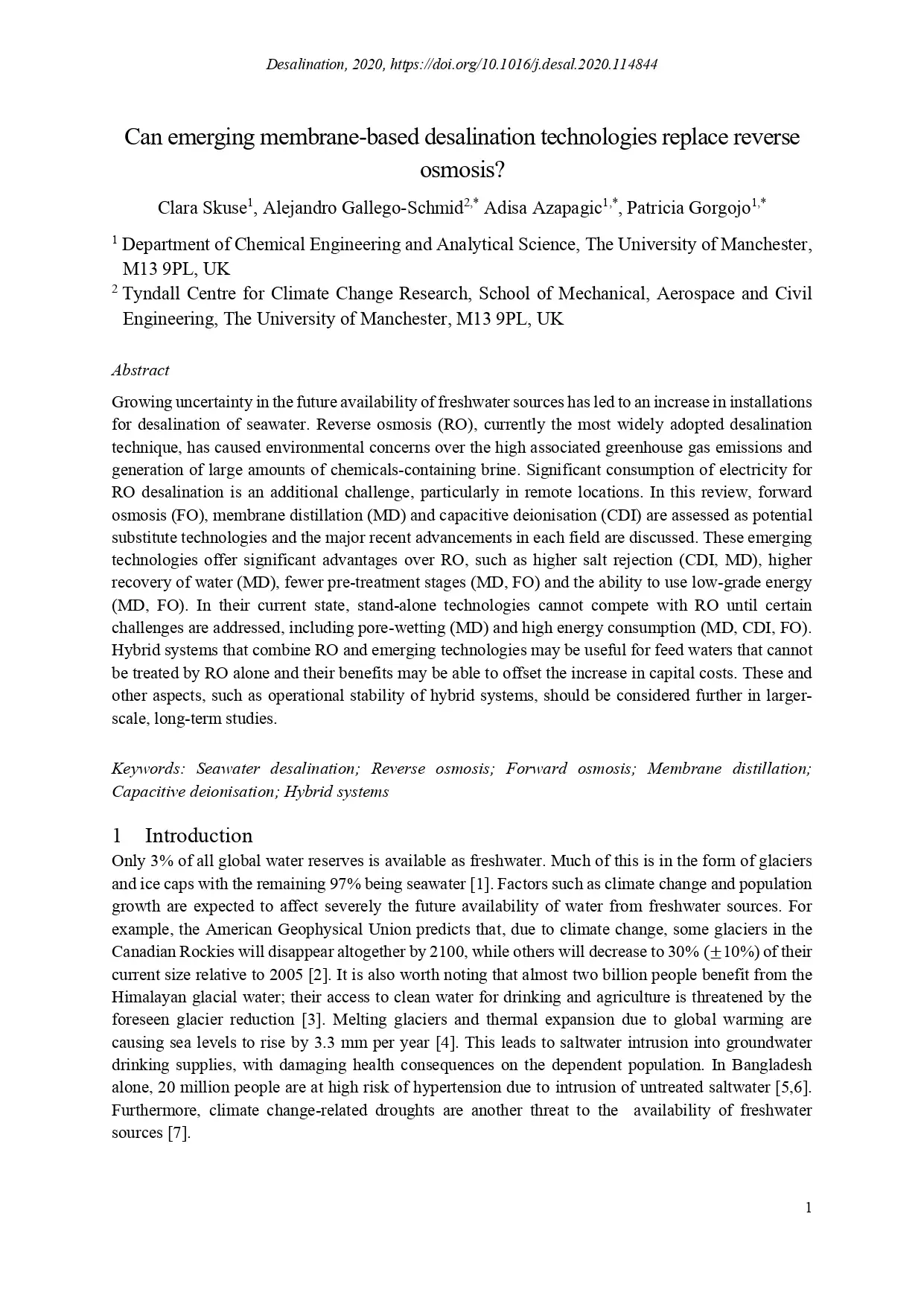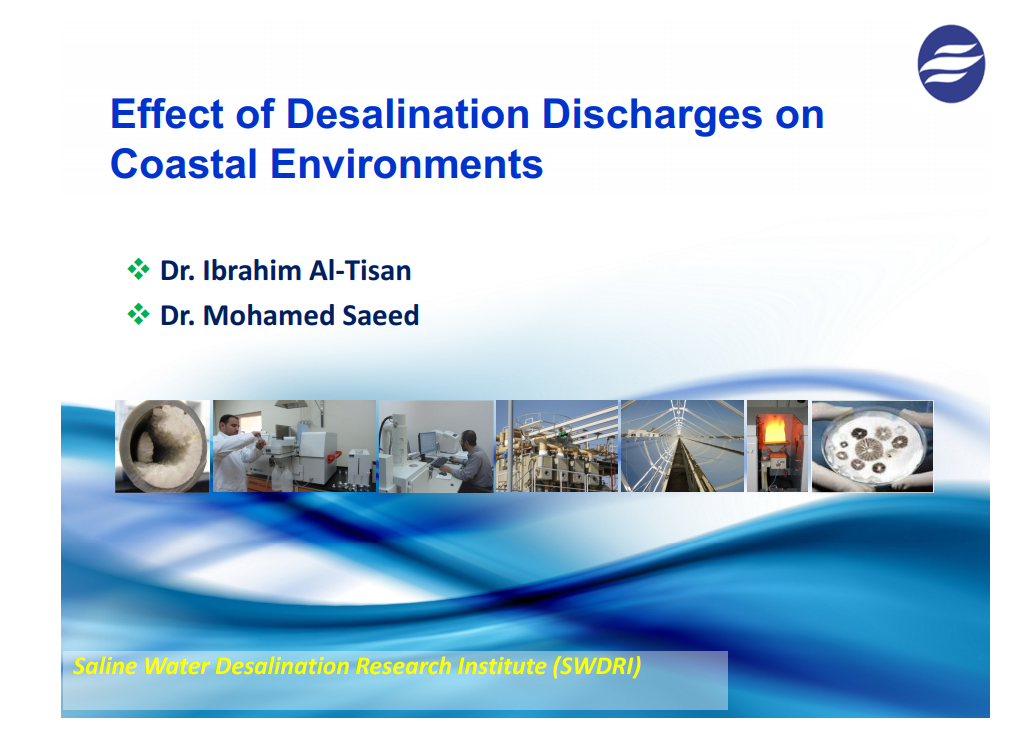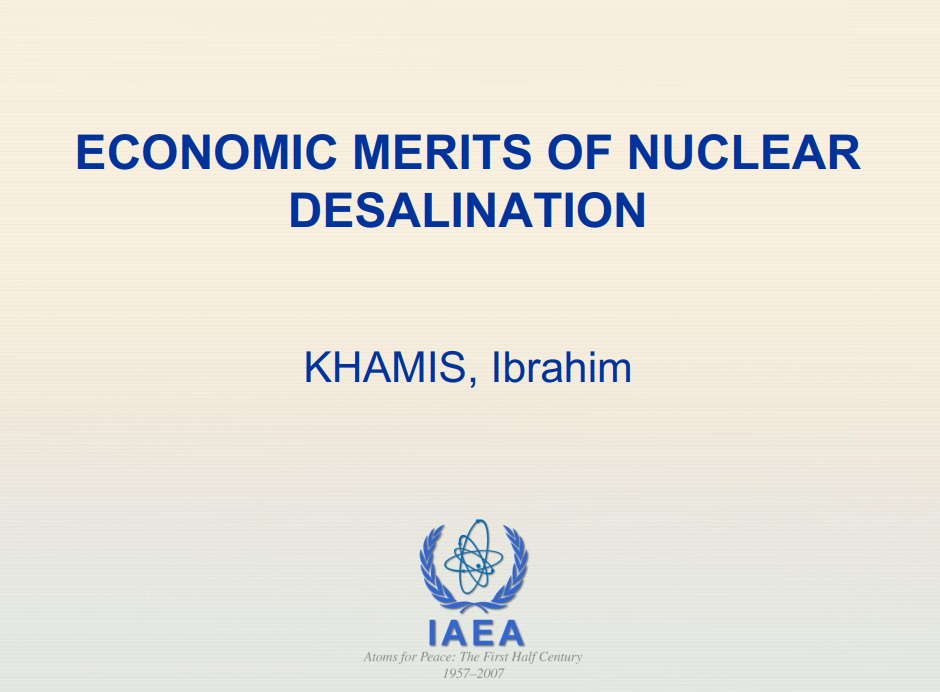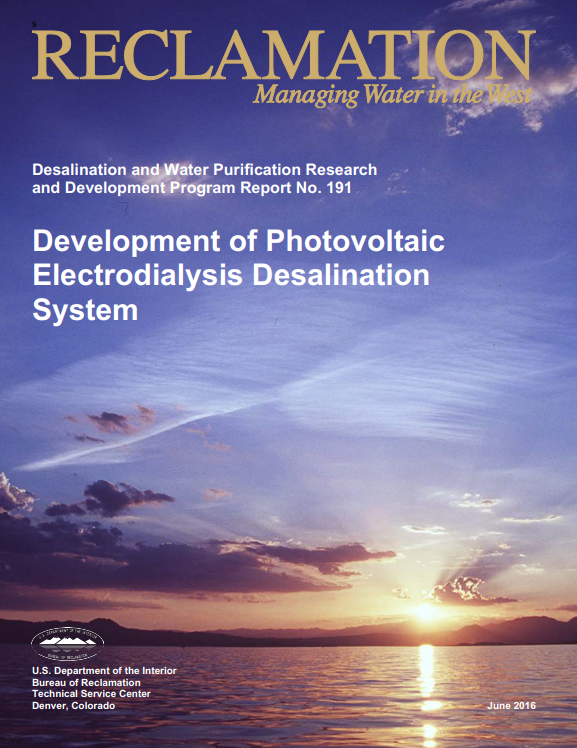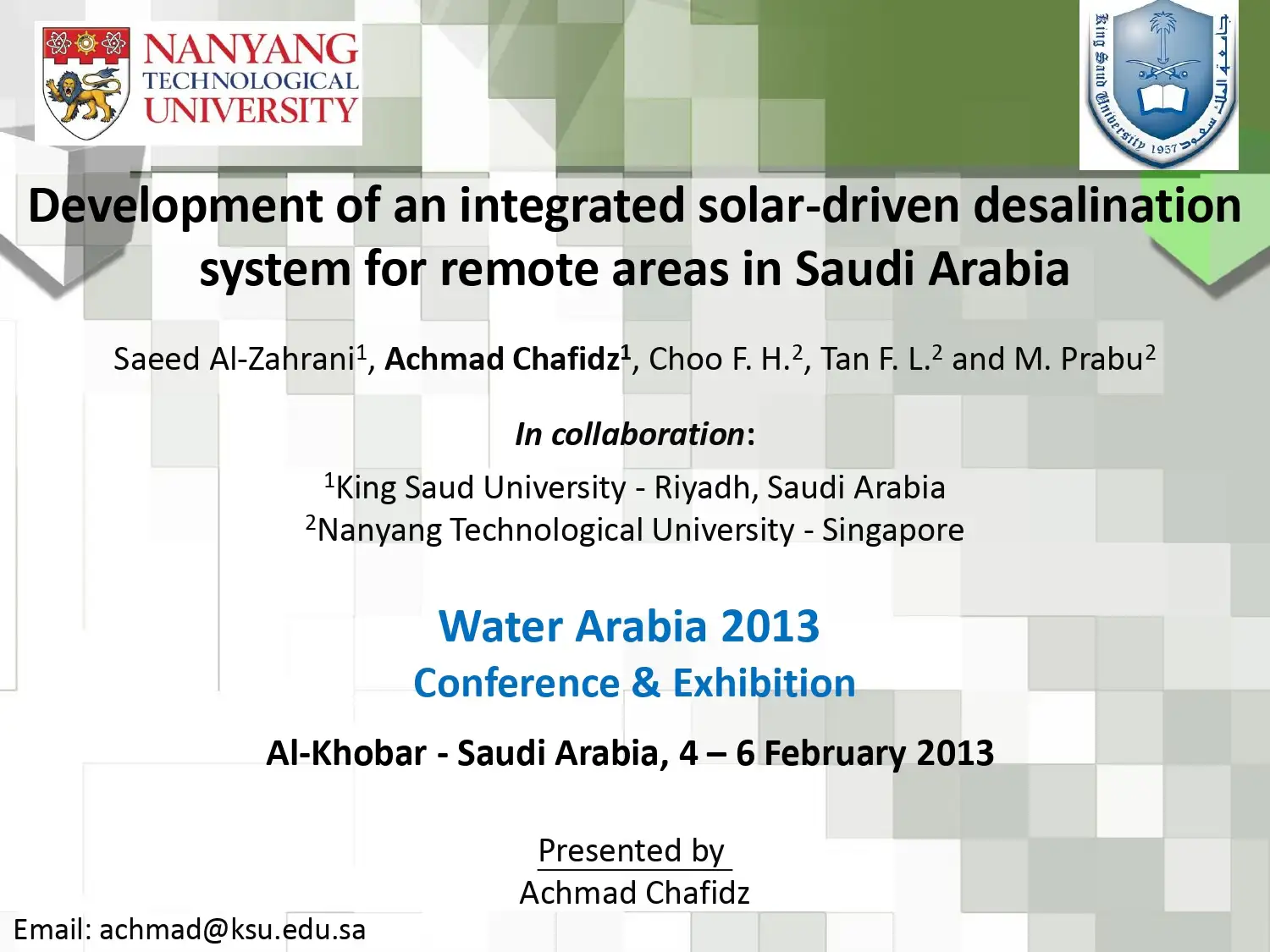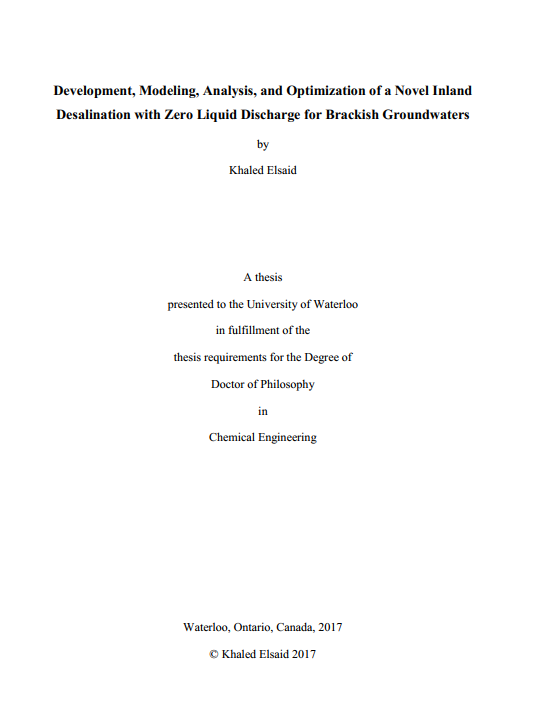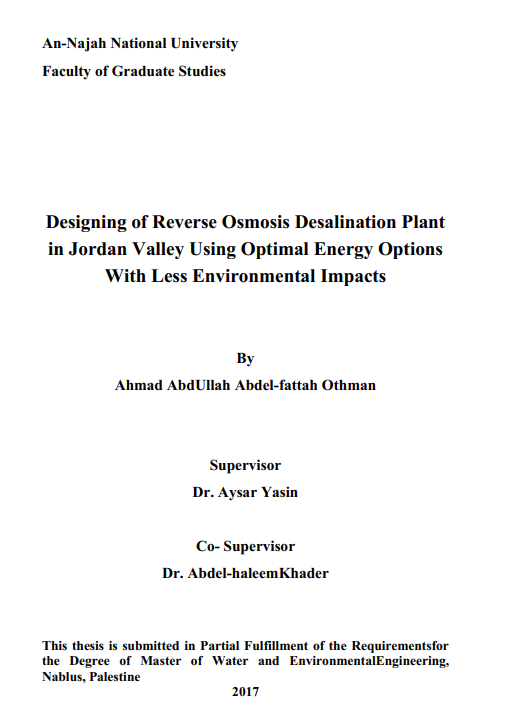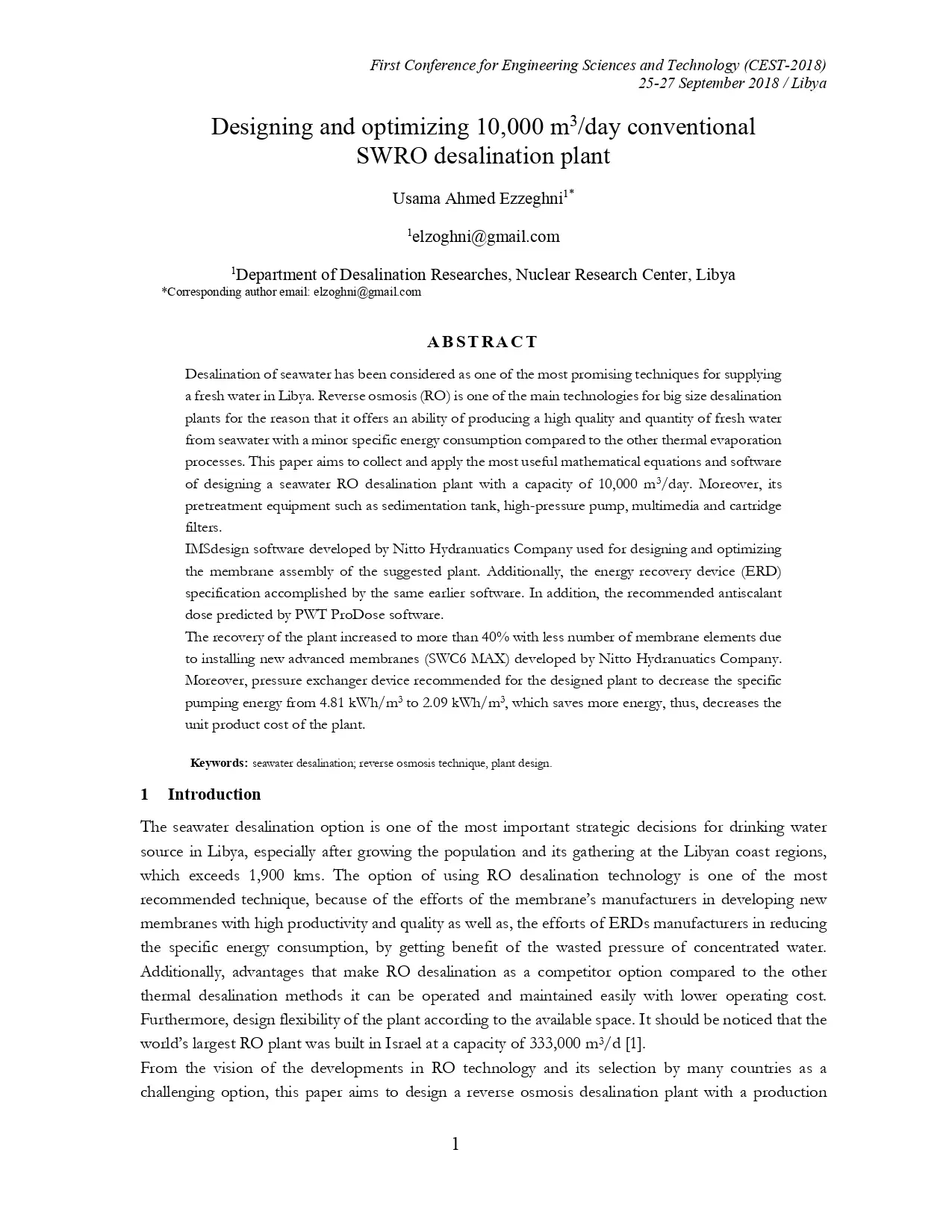Energy Footprint Of Water Desalination
Abstract:
Demand for the freshwater is growing due to the growth of world population that entails growing demand of freshwater for agricultural and industrial purposes. However, the fresh water availability on Earth is limited and many countries face severe water shortages. Water desalination could be a possible solution for this problem. Among the variety of existing water desalination technologies, three are particularly promising, these are: reverse osmosis (RO), multi stage flash (MSF), multi effect distillation (MED). Energy consumption of desalination processes are determined by factors like capacity of desalination plant (small, medium, large), the energy source (electricity vs thermal), type of feed water (brackish (BW) vs seawater (SW)), desalination method (thermal vs membrane), use of renewable energy sources (solar, wind, geothermal), and necessity of feed pretreatment (mechanical and/or chemical). In this paper, I compare the total energy consumption of different methods considering each influential factor and categorizing the existing desalination techniques. Results suggest that the membrane-based technologies are the least energy intensive. 8W RO of medium and large scales require 1.9 kW h/m3. Then comes SW RO of medium size and SW RO of large scale with 4.3 and 4.4 kW h/m3 energy consumption. The thermal desalination techniques, primarily MSF and MED have much higher energy footprint, than the membrane ones. They consume 17.1 and 11.9 kW h/m3 respectively, however, thermal technologies are more efficient for desalination of very salty waters. Nevertheless, membrane-based desalination methods due to their less energy-intensive nature and small footprint became more popular than the thermal technologies and substantial efforts have been observed in integrating RO with renewable energy sources, mainly wind and solar. Energy footprint of this type of desalination techniques is in between the membrane and thermal routes. The energy consumption of renewable powered desalination plants ranges from 1.5 to 21.1 kW h/m3. Their main drawback is small capacity, which makes them non-competitive with conventionally powered plants. We could say that globally humanity spent 7 kW h energy for desalination of 1 m3 of water. For the most of developed countries desalination has large contribution to the total fresh water supply. However, the conventional energy sources are forecasted to be depleted in the near future. The main question is: can desalination satisfy the total fresh water demand at least in the coastal regions within 100 kilometers, where presently about 40% of the world's population live? And should we consider desalination only for municipal purposes or for industrial and agricultural purposes as well? Rough estimation was done regarding the land requirement for solar panels to be able to supply the energy demand from SW RO desalination that is based on solar energy. As a model for such a study I decided to choose a city with 1 million inhabitants located in the territory of Saudi Arabia. To supply 1 million people with fresh water, desalination plant should have 270 000 m3/day capacity for municipal purposes and 1 470 000 m3/day capacity for industrial and agricultural purposes as well. Desalinating freshwater to meet only the municipal purposes a 5.18 km2 of land is required for building a solar park or almost 700 modern soccer fields and for the industrial and agricultural purposes the land requirement increases to — 28.22 km2, which is 3804 soccer fields. The results change, if we change the location of desalination plant, owing mainly to the difference in the amount of radiance that earth surface receives. The sensitivity analysis of a land requirement dependency on radiance was further calculated.
Energy Footprint Of Water Desalination
Abstract:
Demand for the freshwater is growing due to the growth of world population that entails growing demand of freshwater for agricultural and industrial purposes. However, the fresh water availability on Earth is limited and many countries face severe water shortages. Water desalination could be a possible solution for this problem. Among the variety of existing water desalination technologies, three are particularly promising, these are: reverse osmosis (RO), multi stage flash (MSF), multi effect distillation (MED). Energy consumption of desalination processes are determined by factors like capacity of desalination plant (small, medium, large), the energy source (electricity vs thermal), type of feed water (brackish (BW) vs seawater (SW)), desalination method (thermal vs membrane), use of renewable energy sources (solar, wind, geothermal), and necessity of feed pretreatment (mechanical and/or chemical). In this paper, I compare the total energy consumption of different methods considering each influential factor and categorizing the existing desalination techniques. Results suggest that the membrane-based technologies are the least energy intensive. 8W RO of medium and large scales require 1.9 kW h/m3. Then comes SW RO of medium size and SW RO of large scale with 4.3 and 4.4 kW h/m3 energy consumption. The thermal desalination techniques, primarily MSF and MED have much higher energy footprint, than the membrane ones. They consume 17.1 and 11.9 kW h/m3 respectively, however, thermal technologies are more efficient for desalination of very salty waters. Nevertheless, membrane-based desalination methods due to their less energy-intensive nature and small footprint became more popular than the thermal technologies and substantial efforts have been observed in integrating RO with renewable energy sources, mainly wind and solar. Energy footprint of this type of desalination techniques is in between the membrane and thermal routes. The energy consumption of renewable powered desalination plants ranges from 1.5 to 21.1 kW h/m3. Their main drawback is small capacity, which makes them non-competitive with conventionally powered plants. We could say that globally humanity spent 7 kW h energy for desalination of 1 m3 of water. For the most of developed countries desalination has large contribution to the total fresh water supply. However, the conventional energy sources are forecasted to be depleted in the near future. The main question is: can desalination satisfy the total fresh water demand at least in the coastal regions within 100 kilometers, where presently about 40% of the world's population live? And should we consider desalination only for municipal purposes or for industrial and agricultural purposes as well? Rough estimation was done regarding the land requirement for solar panels to be able to supply the energy demand from SW RO desalination that is based on solar energy. As a model for such a study I decided to choose a city with 1 million inhabitants located in the territory of Saudi Arabia. To supply 1 million people with fresh water, desalination plant should have 270 000 m3/day capacity for municipal purposes and 1 470 000 m3/day capacity for industrial and agricultural purposes as well. Desalinating freshwater to meet only the municipal purposes a 5.18 km2 of land is required for building a solar park or almost 700 modern soccer fields and for the industrial and agricultural purposes the land requirement increases to — 28.22 km2, which is 3804 soccer fields. The results change, if we change the location of desalination plant, owing mainly to the difference in the amount of radiance that earth surface receives. The sensitivity analysis of a land requirement dependency on radiance was further calculated.
Can emerging membrane-based desalination technologies replace reverse osmosis?
Abstract:
Growing uncertainty in the future availability of freshwater sources has led to an increase in installations for desalination of seawater. Reverse osmosis (RO), currently the most widely adopted desalination technique, has caused environmental concerns over the high associated greenhouse gas emissions and
generation of large amounts of chemicals-containing brine. Significant consumption of electricity for RO desalination is an additional challenge, particularly in remote locations. In this review, forward osmosis (FO), membrane distillation (MD) and capacitive deionization (CDI) are assessed as potential
substitute technologies and the major recent advancements in each field are discussed. These emerging technologies offer significant advantages over RO, such as higher salt rejection (CDI, MD), higher recovery of water (MD), fewer pre-treatment stages (MD, FO) and the ability to use low-grade energy
(MD, FO). In their current state, stand-alone technologies cannot compete with RO until certain challenges are addressed, including pore-wetting (MD) and high energy consumption (MD, CDI, FO). Hybrid systems that combine RO and emerging technologies may be useful for feed waters that cannot
be treated by RO alone and their benefits may be able to offset the increase in capital costs. These and other aspects, such as operational stability of hybrid systems, should be considered further in large-scale, long-term studies
Can emerging membrane-based desalination technologies replace reverse osmosis?
Abstract:
Growing uncertainty in the future availability of freshwater sources has led to an increase in installations for desalination of seawater. Reverse osmosis (RO), currently the most widely adopted desalination technique, has caused environmental concerns over the high associated greenhouse gas emissions and
generation of large amounts of chemicals-containing brine. Significant consumption of electricity for RO desalination is an additional challenge, particularly in remote locations. In this review, forward osmosis (FO), membrane distillation (MD) and capacitive deionization (CDI) are assessed as potential
substitute technologies and the major recent advancements in each field are discussed. These emerging technologies offer significant advantages over RO, such as higher salt rejection (CDI, MD), higher recovery of water (MD), fewer pre-treatment stages (MD, FO) and the ability to use low-grade energy
(MD, FO). In their current state, stand-alone technologies cannot compete with RO until certain challenges are addressed, including pore-wetting (MD) and high energy consumption (MD, CDI, FO). Hybrid systems that combine RO and emerging technologies may be useful for feed waters that cannot
be treated by RO alone and their benefits may be able to offset the increase in capital costs. These and other aspects, such as operational stability of hybrid systems, should be considered further in large-scale, long-term studies
Development of Photovoltaic Electrodialysis Desalination System
ABSTRACT:
The declining supply of drinking water for an increasing world population is a global concern with impacts on public health as well as micro and macro economies. A Photovoltaic Electrodialysis (PV-ED) unit is designed and constructed. The unit consists of a direct current power supply that charges batteries to provide a constant current to the unit. This includes an electrodialysis stack (desalinization unit), circulation pumps, a concentrate discharge unit, and a control unit to communicate between the photovoltaic and electrodialysis systems. The controller unit in conjunction with several sensors to monitor flow, conductivity, pressure, water elevation levels, and temperature creates a closed loop feedback system. The logic used in the control system was developed after physical construction of the unit. A closed loop feedback system allows battery charging, power regulation, and product water parameters to be precisely controlled while maintaining maximum efficiency. Based on the experience obtained during this research, the team at Cal Poly Pomona has estimated that this small PV-ED unit can be manufacture with a unit cost of $4,000. The Cal Poly Pomona team is looking into opportunities for implementation of this decentralized PV-ED unit in a disadvantaged community (DAC) in California.
Development of Photovoltaic Electrodialysis Desalination System
ABSTRACT:
The declining supply of drinking water for an increasing world population is a global concern with impacts on public health as well as micro and macro economies. A Photovoltaic Electrodialysis (PV-ED) unit is designed and constructed. The unit consists of a direct current power supply that charges batteries to provide a constant current to the unit. This includes an electrodialysis stack (desalinization unit), circulation pumps, a concentrate discharge unit, and a control unit to communicate between the photovoltaic and electrodialysis systems. The controller unit in conjunction with several sensors to monitor flow, conductivity, pressure, water elevation levels, and temperature creates a closed loop feedback system. The logic used in the control system was developed after physical construction of the unit. A closed loop feedback system allows battery charging, power regulation, and product water parameters to be precisely controlled while maintaining maximum efficiency. Based on the experience obtained during this research, the team at Cal Poly Pomona has estimated that this small PV-ED unit can be manufacture with a unit cost of $4,000. The Cal Poly Pomona team is looking into opportunities for implementation of this decentralized PV-ED unit in a disadvantaged community (DAC) in California.
Development, Modeling, Analysis, and Optimization of a Novel Inland Desalination with Zero Liquid Discharge for Brackish Groundwaters
ABSTRACT:
Groundwater is considered the major source of domestic water supply in many countries worldwide. In the absence of surface water supplies, the use of groundwater for domestic, agricultural, and even for industrial purposes becomes essential, especially in rural communities. Groundwater supplies typically are of good quality, and the quality is reasonably uniform throughout the year compared to that of surface water, thus making it suitable for direct use, or
simple to treat. A disadvantage of groundwater is the content of dissolved salt as many have a moderate-to-high salinity. The high salinity makes water brackish and thus it requires desalination before use. This has led to wide use of groundwater desalination to produce good-quality water in
many regions around the world. Nevertheless, a problem of desalination processes is the generation of a concentrate stream, sometimes called brine or reject, which must be properly managed. The management of brine from brackish groundwater desalination is a significant issue if located far from the coast (i.e. inland plants) or far from public channel to discharge such brine. Some options for brine disposal from inland desalination plants are evaporation ponds, deepwell injection, disposal to municipal sewers, and irrigation of plants tolerant to high salinities. Each of these disposal methods may result in many environmental problems such as groundwater contamination, the decline in crop yields from agricultural lands, the formation of eyesores, decreasing the efficiency of biological wastewater treatment, and making treated sewage effluent unsuitable for irrigation. As a result, the brine management from inland desalination of brackish groundwater is very critical, and the need for affordable and environmentally benign inland desalination has become crucial in many regions worldwide. This work aims to develop an efficient and environmentally benign process for inland desalination of brackish groundwater, which approaches zero liquid discharge (ZLD), maximizing the water produced and minimizing the volume of concentrate effluent. The technical approach
involves utilization of two-stage reverse osmosis (RO) units with the intermediate chemical treatment of brine stream that is designed to remove most of the scale-forming constituents, which foul membrane surface in RO and limits its water recovery and hence enable further recovery of water in the secondary RO unit.
Development, Modeling, Analysis, and Optimization of a Novel Inland Desalination with Zero Liquid Discharge for Brackish Groundwaters
ABSTRACT:
Groundwater is considered the major source of domestic water supply in many countries worldwide. In the absence of surface water supplies, the use of groundwater for domestic, agricultural, and even for industrial purposes becomes essential, especially in rural communities. Groundwater supplies typically are of good quality, and the quality is reasonably uniform throughout the year compared to that of surface water, thus making it suitable for direct use, or
simple to treat. A disadvantage of groundwater is the content of dissolved salt as many have a moderate-to-high salinity. The high salinity makes water brackish and thus it requires desalination before use. This has led to wide use of groundwater desalination to produce good-quality water in
many regions around the world. Nevertheless, a problem of desalination processes is the generation of a concentrate stream, sometimes called brine or reject, which must be properly managed. The management of brine from brackish groundwater desalination is a significant issue if located far from the coast (i.e. inland plants) or far from public channel to discharge such brine. Some options for brine disposal from inland desalination plants are evaporation ponds, deepwell injection, disposal to municipal sewers, and irrigation of plants tolerant to high salinities. Each of these disposal methods may result in many environmental problems such as groundwater contamination, the decline in crop yields from agricultural lands, the formation of eyesores, decreasing the efficiency of biological wastewater treatment, and making treated sewage effluent unsuitable for irrigation. As a result, the brine management from inland desalination of brackish groundwater is very critical, and the need for affordable and environmentally benign inland desalination has become crucial in many regions worldwide. This work aims to develop an efficient and environmentally benign process for inland desalination of brackish groundwater, which approaches zero liquid discharge (ZLD), maximizing the water produced and minimizing the volume of concentrate effluent. The technical approach
involves utilization of two-stage reverse osmosis (RO) units with the intermediate chemical treatment of brine stream that is designed to remove most of the scale-forming constituents, which foul membrane surface in RO and limits its water recovery and hence enable further recovery of water in the secondary RO unit.
Designing of Reverse Osmosis Desalination Plant in Jordan Valley Using Optimal Energy Options With Less Environmental Impacts
General introduction:
When population growing, water demand for domestic, agricultural and industrial needs is increasing. Fresh water resources are now widely exploited over the world due to increasing population and the amount of potable water will be decreased so, the other sources of water require some form of treatment before potable use without interruption and with reasonable cost to the consumer. Desalination technologies have appeared since 1950s at large scale plant with thermal processes like Multi Stage Flash Distillation (MSF) and Multi Effect Distillation (MED). Heating processes became established using the plenty
supply of available oil-driven energy for the required heating process[1]. The Reverse Osmosis (RO) process, developed since 1970s, is the main alternative to the previous technologies that require less amount of energy than thermal processes [1]. The desalination of ground water has more interest especially in Jordan Valley region due to high amount of salinity (Total Dissolve solids TDS). The design and operation of treatment plant depends on the feed water
quality in order to decide which pretreatment, feed pressure, recovery and waste disposable method is selected since the energy consumption is related directly to feed water TDS[2]
Designing of Reverse Osmosis Desalination Plant in Jordan Valley Using Optimal Energy Options With Less Environmental Impacts
General introduction:
When population growing, water demand for domestic, agricultural and industrial needs is increasing. Fresh water resources are now widely exploited over the world due to increasing population and the amount of potable water will be decreased so, the other sources of water require some form of treatment before potable use without interruption and with reasonable cost to the consumer. Desalination technologies have appeared since 1950s at large scale plant with thermal processes like Multi Stage Flash Distillation (MSF) and Multi Effect Distillation (MED). Heating processes became established using the plenty
supply of available oil-driven energy for the required heating process[1]. The Reverse Osmosis (RO) process, developed since 1970s, is the main alternative to the previous technologies that require less amount of energy than thermal processes [1]. The desalination of ground water has more interest especially in Jordan Valley region due to high amount of salinity (Total Dissolve solids TDS). The design and operation of treatment plant depends on the feed water
quality in order to decide which pretreatment, feed pressure, recovery and waste disposable method is selected since the energy consumption is related directly to feed water TDS[2]
Designing And Optimizing 10,000 m 3 /day Conventional SWRO Desalination plant
ABSTRACT:
Desalination of seawater has been considered as one of the most promising techniques for supplying a fresh water in Libya. Reverse osmosis (RO) is one of the main technologies for big size desalination plants for the reason that it offers an ability of producing a high quality and quantity of fresh water
from seawater with a minor specific energy consumption compared to the other thermal evaporation processes. This paper aims to collect and apply the most useful mathematical equations and software of designing a seawater RO desalination plant with a capacity of 10,000 m3/day. Moreover, its
pretreatment equipment such as sedimentation tank, high-pressure pump, multimedia and cartridge filters. IMSdesign software developed by Nitto Hydranuatics Company used for designing and optimizing the membrane assembly of the suggested plant. Additionally, the energy recovery device (ERD)
specification accomplished by the same earlier software. In addition, the recommended antiscalant dose predicted by PWT ProDose software. The recovery of the plant increased to more than 40% with less number of membrane elements due to installing new advanced membranes (SWC6 MAX) developed by Nitto Hydranuatics Company. Moreover, pressure exchanger device recommended for the designed plant to decrease the specific pumping energy from 4.81 kWh/m3 to 2.09 kWh/m3, which saves more energy, thus, decreases the unit product cost of the plant.
Designing And Optimizing 10,000 m 3 /day Conventional SWRO Desalination plant
ABSTRACT:
Desalination of seawater has been considered as one of the most promising techniques for supplying a fresh water in Libya. Reverse osmosis (RO) is one of the main technologies for big size desalination plants for the reason that it offers an ability of producing a high quality and quantity of fresh water
from seawater with a minor specific energy consumption compared to the other thermal evaporation processes. This paper aims to collect and apply the most useful mathematical equations and software of designing a seawater RO desalination plant with a capacity of 10,000 m3/day. Moreover, its
pretreatment equipment such as sedimentation tank, high-pressure pump, multimedia and cartridge filters. IMSdesign software developed by Nitto Hydranuatics Company used for designing and optimizing the membrane assembly of the suggested plant. Additionally, the energy recovery device (ERD)
specification accomplished by the same earlier software. In addition, the recommended antiscalant dose predicted by PWT ProDose software. The recovery of the plant increased to more than 40% with less number of membrane elements due to installing new advanced membranes (SWC6 MAX) developed by Nitto Hydranuatics Company. Moreover, pressure exchanger device recommended for the designed plant to decrease the specific pumping energy from 4.81 kWh/m3 to 2.09 kWh/m3, which saves more energy, thus, decreases the unit product cost of the plant.


